In-Depth with the Windows 8 Consumer Preview
by Andrew Cunningham, Ryan Smith, Kristian Vättö & Jarred Walton on March 9, 2012 10:30 AM EST- Posted in
- Microsoft
- Operating Systems
- Windows
- Windows 8
As soon as the setup process is finished, you’re presented with your first look at Windows 8’s primary innovation: Metro. This new UI, which originated in Windows Phone 7 and has since been extended to the Xbox 360, is the Wave of the Future at Microsoft, and it’s part and parcel of Windows 8. There is no classic Start menu to fall back on. There’s nothing built-in to the OS that allows you to disable it or boot to the desktop by default (though surely various hacks will enable this if they haven’t already). Metro is here, and if you use Windows 8 you’ll have to come to terms with it.
That’s because Microsoft is going a step further than Apple with regards to its operating systems: while Apple is busy porting iOS features and characteristics to a desktop operating system that is still recognizably OS X, Microsoft insists that the tablet is just another kind of PC, and to that end is building a unified OS for both tablets and traditional PCs. Microsoft tablets (whether running Windows 8 or Windows on ARM) will run the same core software as PCs, will be able to run many of the same apps as PCs, and (most importantly for Microsoft’s ecosystem of enterprise users) can be managed using the same tools as PCs. We’ve known for years that the traditional Windows desktop doesn’t work well on tablets, but does an interface designed for touch also work with a mouse and keyboard?
 Metro, with its large fonts, bold colors, and large buttons was designed to be touched, and I think once we get some tablets designed for Windows 8 people are going to warm up to it. It’s well thought-out and with a little polishing will stand up well to iOS and Android in terms of features, and in terms of aesthetics it's already there—animations are fluid and attractive, and nice touches like a volume overlay (see right—finally!) bring an extra level of modern polish to Windows.
Metro, with its large fonts, bold colors, and large buttons was designed to be touched, and I think once we get some tablets designed for Windows 8 people are going to warm up to it. It’s well thought-out and with a little polishing will stand up well to iOS and Android in terms of features, and in terms of aesthetics it's already there—animations are fluid and attractive, and nice touches like a volume overlay (see right—finally!) bring an extra level of modern polish to Windows.
Brian Klug and Ryan Smith talked a bit about using Metro on a tablet in their piece on September’s Windows 8 Developer Preview, a process which is more or less the same in the Consumer Preview, so what I’ll be focusing on here is the general layout and function of Metro in the Consumer Preview, and my experience using it with a keyboard and mouse.
Introducing Metro
We’ll start with the entry point: the new login/lock screen. In previous Windows versions, this screen told you nothing about the computer—it was simply a gateway, and as such it either showed you a list of user accounts on the computer or displayed a CTRL + ALT + DELETE prompt with username and password fields. In Windows 8, the lock screen shows you the date and time and your current battery life and network connectivity status, set against a user-configurable background. Other Metro apps, like Mail and Messages, can also be configured to display status and notification messages on the lock screen. The look is reminiscent of most tablets and smartphones, but its big, high-resolution, striking images reminded me more of the Kindle Fire than anything. It’s a nice effect.
Press any key on your keyboard and the login image will slide upward, revealing the traditional Windows name and password fields. Authenticate, and you’ll be looking at the Metro-style Start screen.
Tiles for Metro-style apps are big and colorful, and can usually be set to two sizes, a smaller square that allows for two tiles to sit side by side in a column, and a longer rectangle that spans the entire column. Metro columns on the Start screen will expand or contract to fill all of the screen resolution available to them, as evidenced in the screenshots above and below, and your mouse or trackpad’s vertical scrolling function will let you move left and right (horizontally, I know) through all of your apps. You can also scroll by grabbing the scrollbar at the bottom of the screen, or by moving your mouse pointer all the way to the left or the right of the screen.
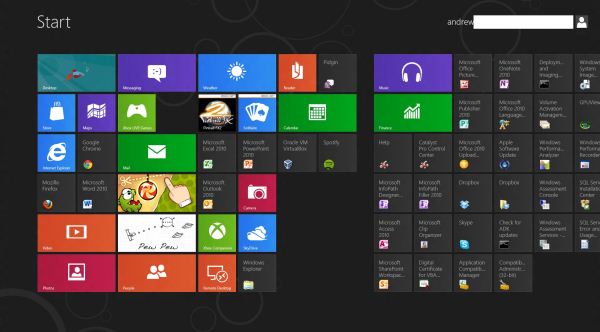
Displays with more pixels can display more items
Above, you can see most of what constitutes a Metro page: tiles of apps lined up into neat columns. Tiles can be moved around at will, and will try their best to rearrange themselves dynamically. The wider gap between two of the columns is a divider between “pages” of apps. There is no limit to the horizontal size of pages, and you can freely drag tiles to either side of these wider divides.
Right-clicking a Metro app will bring up a list of actions at the bottom of the screen—most Metro tiles will let you shorten or lengthen them, remove them from the Start screen, or uninstall them.
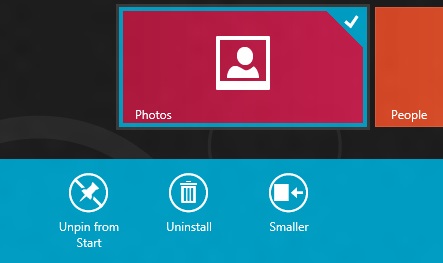
Standard desktop programs also show up on the Start screen as rather unglamorous-looking gray tiles that show the name of the program and its icon. Left clicking on it will dump you to the desktop and open the app as it would open in older versions of Windows, and right-clicking will bring up that app’s standard right-click menu in the Metro style across the bottom of the screen, with the added option to uninstall the program without going into the Programs and Features control panel.
To add and remove desktop app icons from the Start screen, right-click them and then click “pin to Start.” Desktop apps can be pinned to and unpinned from the desktop taskbar and the Start screen from the desktop or from Metro, the first of many ways in which the two interfaces are integrated.
Windows Search can be invoked automatically from the Start screen if you begin typing. In Windows 8, there are three distinct search categories: Apps, which will display most Metro and desktop programs; Settings, which will search through the Metro and desktop control panels; and Files, which is self-explanatory. You can also search through any Windows Search-enabled Metro app, which you can see listed below the three main headings. I’d love to see a unified search group like we had in the Windows 7 Start menu, especially given the sometimes-blurry line between what appears in Settings and what appears in Apps, but search in Windows 8 is powerful and it’s fast, even using slower processors and mechanical HDDs.
All Metro apps, including the desktop, can be “snapped” to the left or right edge of the screen, which lets one app use up about a fifth of the screen while another app uses the remaining space—I’ve seen this called “Metro Snap” and that’s how I’ll refer to it for the rest of the article. This is especially useful for things like Twitter or messaging clients that work well with a single vertical strip of screen space. Metro Snap will only work on panels that are 1366x768 or higher—anything smaller has too few horizontal pixels to make effective use of the feature—but the Windows desktop’s Aero Snap features will continue to work as they did in Windows 7.
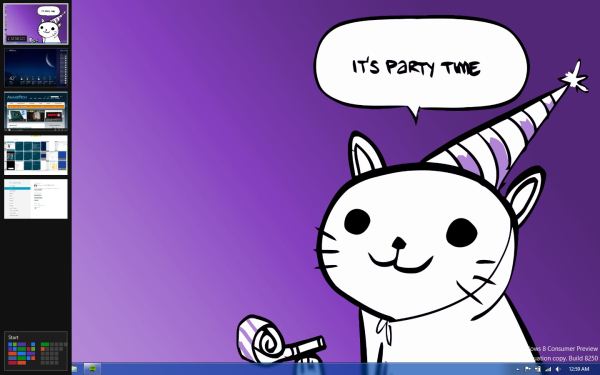
Party Cat knows when it is time to party. Also, the app drawer is on the left.
Metro has a few menus that can always be brought up no matter what app you’re using: the left edge of the screen is for an application drawer (above), which serves a function similar to the application switchers in iOS and Android. It shows all of your currently running apps and allows you to either switch to them from the currently running app or close them. The desktop will show up in the application drawer as a single item regardless of how many programs you have running on it, and while you can “close” it, this only makes the tile vanish from the drawer, and won’t close any of the programs running on the desktop.
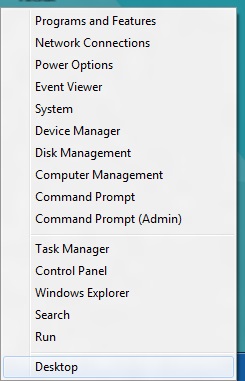
Update: Several readers have pointed out that right-clicking in the lower left corner of the screen brings up a mini-Start menu of sorts, where the Explorer, Search, the Run dialog box and several control panels can be accessed more easily. Thanks to all who sent this in!
The right edge of the screen is for Charms (above), Microsoft’s name for the buttons that let you access several high-level settings and features. The Charms are, from top to bottom:
- Search, which brings up the Search menu (which, remember, can also be invoked by typing from the Start screen). The default search view is Apps.
- Share. While in a Metro app like Photos, you could use this charm to send a picture to someone using another Metro app like Mail.
- Start, which brings up the Start screen.
- Devices, which brings up attached devices like printers and extra monitors and gives you some configuration options for them—for instance, it will allow you to change your display settings if you’ve got a second monitor or projector attached, and it will bring up a Print menu if you click an attached printer. This charm is context-sensitive—if there’s nothing in your app to print (or if the app doesn’t support it), for example, any printers attached to your computer won’t show up in the menu as a selectable option.
- Settings. This brings up both general settings and options for the currently-running application as well as some system-wide settings like brightness, volume, notifications, language, network connectivity, and shutdown options. The “More PC Settings” link brings up the system-wide Metro control panel, where one can control things like the lock screen and Metro backgrounds, your PC’s refresh and reset functionality, and a few other settings.
Screen resolution requirements
As we’ve discussed, using Metro Snap requires a screen resolution of at least 1366x768, but there’s one more very important resolution requirement in Windows 8.
While working on my netbook, I quickly found that almost all Metro apps included in the Consumer Preview wouldn’t run on its 1024x600 display. After some research I found that, yes, Metro apps are only going to run on screens that are 1024x768 or higher. It’s important to give developers a minimum screen resolution to shoot for (and we may even see some tablets that use 1024x768 panels, given the precedent set by the iPad, the HP TouchPad, and others), but it means that users of PCs with smaller screens aren’t going to be able to use Windows 8’s defining feature (though the Start screen and system menus will still work just fine). This is too bad, since the limited amount of screen space on a netbook is a decent fit for Metro's simplified interface and full-screen apps.
Now that you know the basic features and layout of Metro, it’s time to teach you how to use it with a mouse and keyboard.


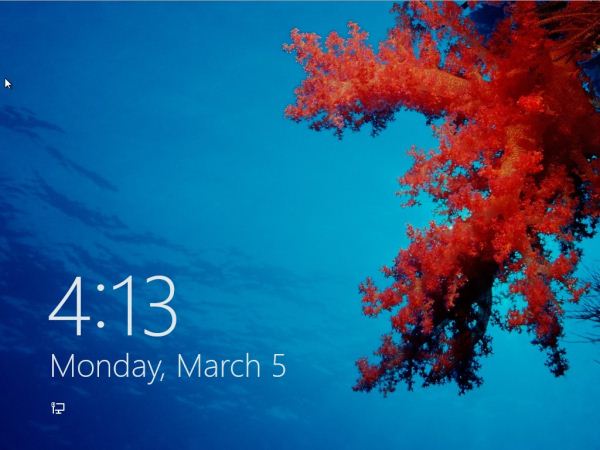
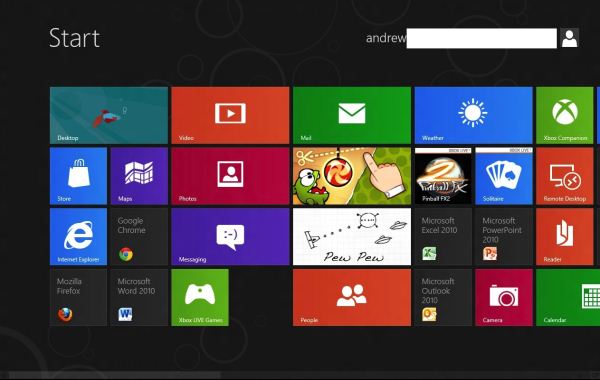
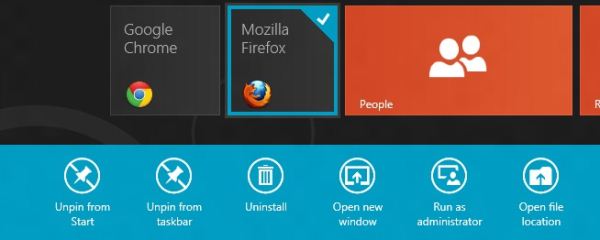
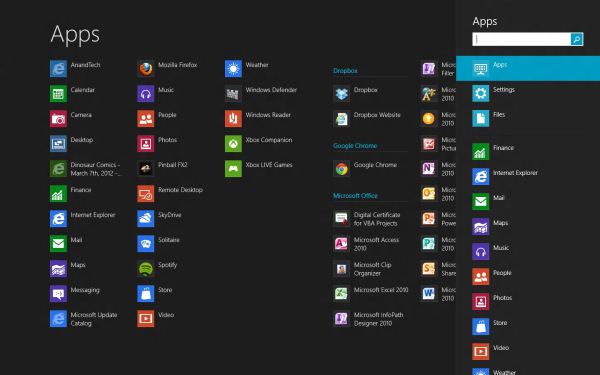
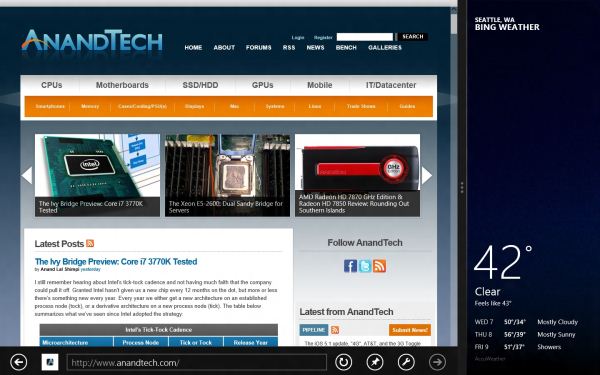
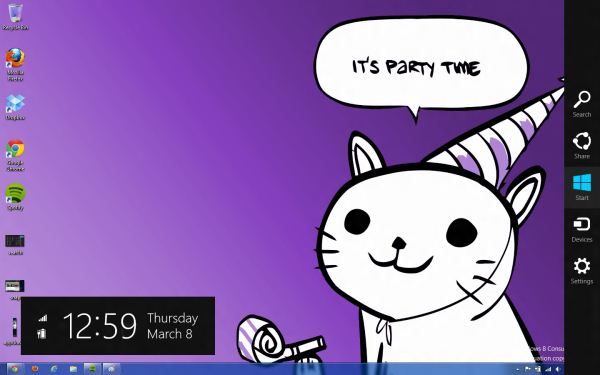








286 Comments
View All Comments
Andrew.a.cunningham - Saturday, March 10, 2012 - link
I've seen that from a couple of other people... Not sure how I missed it. It's on a list of small updates I need to make to the article that I hope I can get to tomorrow.Cardio - Saturday, March 10, 2012 - link
I am running Win 8 CP on a new build Asus Z68, SB @4.7, a Mushkin Chronos SSD and a GTX 580.First I think this is an exceptionally well done review. It is an OS review not hardware. There is no reason to think that the OS will work differently on an AMD or an Intel anymore than win 7 did. I am pretty sure that MS knows there are AMD systems out there and is not going to release an OS that will not run properly on them, seems like that would be the best business plan. I, for one, see nothing wrong with Windows 8. It is faster than 7 and has been completely stable for me and compatible with everything I have tried with the sole exception of CPUZ and ASUS's multiple driver install program that sees it as an unknown OS. The drivers still install normally if done separately.
It is different. Most of the complaints I hear are based just on that. Personally, I wouldn't want it if it wasn't different. If you don't want it don't buy it. If you don't want to do things in a different way you sure don't have to... Windows 7 is and will still be around. All this predictable ranting is the same as happened when DOS went away and every other OS change since. I have used Win 8 enough that the changes in use are now normal and you don't have to think about it. I'm sure before RTM and there after there will be more changes. Thanks for the very nice review. I can imagine what a job it was.
taltamir - Saturday, March 10, 2012 - link
"Metro is here, and if you use Windows 8 you’ll have to come to terms with it."Then I wont be using windows 8.
eezip - Saturday, March 10, 2012 - link
Am I the only one that has trouble with this? I can sign in at https://login.live.com/ and have no problems at all, so I figured that was the login info to use.I installed the Dev Preview when it was released and used a local account. But after recalling the Win8 blog post about Win Live ID syncing, I figured I'd try it before moving to the CP. So I went into the settings and selected "Switch to a Microsoft Account". Seems logical. But I was unable to log in again to the Dev Preview install. Arrrrgh!
So, I clean installed the CP and tried using the Windows Live ID login info from the beginning. I got to the desktop, but the first time I restarted the computer, I couldn't log in. I had entered my phone number and hint info, but I never saw how to enter it. And the CP certainly didn't offer to help me when I was clearly struggling. Since I didn't have a local account, I reinstalled the CP using a local account, which brings me to today.
Is my login at https://login.live.com/ the same login that I *should* be able to use for Win8? I can only assume that I'm doing something wrong, but I sure don't know what it might be.
InsaneScientist - Saturday, March 10, 2012 - link
How long is your password?Try just the first 16 characters if it's longer than that.
For whatever (REALLY STUPID) reason, it'll let you enter a password longer than that, but it only uses the first 16 as the actual password.
(See my comment two below yours, and poke around on google. It's a known issue)
If it's not longer than 16 characters... I have no idea.
b_wallach - Saturday, March 10, 2012 - link
Well what is a in depth when there is nothing very in depth at all. With all the systems tested here it's really a drag that you can't dig up a AMD system and the one everyone wants to see is the BD line.Most people have seen enough to say if you wanted to do a run with the new OS it would be with this cpu because of all the guesses and some beta tests that showed a marked improvement with these cpu's.
Running a bunch of lame Intel systems really makes it kind of a joke. If you did not have a good selection of different brands then why not delay it until you have enough systems to call it a in depth review instead of a who cares review. I'm sure most would say the intel's would do good and so nothing worth noting was done that would add to a lot of how much better will a radical cpu design work on it as everything points to this being a top of the list things people want to know about the new OS.
With some win8 beta tests showing a 5-10% increase I'm sure everyone that has the new BD's has been waiting to see this one over any of the no real supprise Intel lines.
As always it leaves a fairly large question mark about just what can expect from a site that has been less than honest about AMD for many years.
It's only lately I've even come back here after what went on with bad reviews and very few when AMD first put out their first FX line that was better but trying to avoid the Intel inside ads all over and great praise for Intels horrible egg cooker cpu made me stop comming here for many years. I can't understand why anyone would not put AMD's new cpus right up front with Window's 8 so we can get a good amount of data over this hugely argued point all over the web.
So no this was anything but a in depth review. It was a candy coated and/or we need to run a filler story to help the hit counter stay busy right???
Before that Pentium 4 fiasco I came here a lot.
After that I started looking at a lot of other sites where the useful data WAS useful. Intel knew what sites to throw a lot of money or inflence as they hit the top sites of the day, Tom's hardware was also doing the same line of crap and like this site I took a few years leave until they could earn back what little trust in them.
I'm sure some other sites will get the AMD BD / Win 8 test done. I can't wait to see if all the flack about AMD and windows had merrit. If not I'll stick with Win 7.
Sorry about being so glib, this IS a good site now, I just hate it when they don't pay much mind about what has been the top interest about windows 8 because AMD has a lot riding on how well their new cpu's will do with it. If it follows the beta tests it would move the AMD right up into the level of being a competitor as they are very close with current Intel cpus in some areas, even pass intel in quite a few other tests and if they see a 5 to 10% it would def. make AMD's cpu a contender. Not a top of the line one but it would put it where AMD wanted to see it run.
Now that would alone make it a in depth review..
It would even be a huge news item to run if AMD can do as well as the WIn8 beta reviews people might not bash it so much. AMD built this design for what could be a very sound call because a huge portion of computer users may or may not know is software is putting more demands, a lot of people run programs that can work very well in the multi-threaded apps as I have seen quite a few new ones use it and it will probably get more demanding use running 2-5 or more progs at the same time. AMD's new cpu does this part very very well.
Oh well, it seems like me most wanted AMD scores because it is very important towards AMD's future if they can pull the scores that the beta revew saw.
It can be compared to buying a upgraded cpu because new cpu's usually give this kind of increase from old cpu's scores and their new cpu's can do.
Still, it's got a lot of potential once people start coding prog's to work well with new cpu designs. Intel hsa had to face this when a lot of their products acted even worse than the current AMD performance numbers.
Even if I'm totally wrong about a details it's funny to read bad stuff about these cpu's. They do have some issues but for the most part they are still a very fast cpu and will run all software pretty darn fast.
Andrew.a.cunningham - Saturday, March 10, 2012 - link
This was a feature review/preview, not so much a performance review/preview. We'll be measuring performance more thoroughly when we have the RTM build in a few months.InsaneScientist - Saturday, March 10, 2012 - link
Maybe because it's an indepth article on the OS itself and not so much a re-review of every piece of hardware released in the last 5 years to see how it'll run Win 8? Sound reasonable?And no, how bulldozer improves (or doesn't) ISN'T what everyone wants... what everyone wants is to know if they'll be able to use the new interface. Talk to anyone who has any experience with Win8 - Metro WILL come up (fast), bulldozer? - not so much.
Oh, and as a side note, I can't speak for the initial release of the A64 vs P4 days, but I started coming here around the time the A64X2 and Pentium D came out, and I rather remember Anandtech calling it like it was... the performance was not too dissimilar, with the A64X2 having an advantage (sometimes a large one - occasionally a disadvantage), but the Pentium D needing and ungodly amount of power and heat to be competitive with it. They've always done a good job of calling it like it is! I've never understood where the claim that they're Intel biased comes from.
Don't get me wrong, I also want to know if it's going to help (and I really hope it does), but it's just not that important. Mostly because CPUs - both Intel's and AMD's - are generally fast enough.
To quote you: "[Bullzoder CPUs] do have some issues but for the most part they are still a very fast cpu and will run all software pretty darn fast."
Yes! That's it exactly! They're fast enough that it's no longer critical to be looking at hardware performance with a new operating system. Instead, when we look at a new operating system, we want to see... well... that operating system.
Furthermore, this isn't a final release. Software development develops features and then the feature set is locked and the codebase is optimized. So performance WILL change between now and RTM (and it would not be fair to AMD to test it now). Features, on the other hand are pretty close to final, so talking about those is fair game.
On the issues that everyone is talking about (Metro, UI, and feature changes), Andrew et al. did an excellent job, and I applaud them for that.
InsaneScientist - Saturday, March 10, 2012 - link
Have they done anything in the CP about that blasted 16 character limit on (live account linked) passwords?This is (in my opinion) by FAR the most egregious step backwards on Windows 8. Why on earth is there a limit on this? It's 2012 for crying out loud!
And the need for an "All" option (which should be the default) in search from the start screen. I'm seriously considering skipping Win8 just because of this.
I don't mind Metro much, it's not my favorite, but I can work with it... but why oh why did the search functionality have to take a step backwards after they got me hooked on it in Win7. :(
I may be able to use it with the keyboard search shortcuts you mentioned, but that's not exactly a ringing endorsement.
MamiyaOtaru - Saturday, March 10, 2012 - link
" In 2009, Windows 7 brought WDDM 1.1, which focused on reducing system memory usage by removing redundant data, and support for heterogeneous GPU configurations, a change that precluded modern iGPU + dGPU technologies such as NVIDIA’s Optimus."I don't think "preclude" means what you think it means